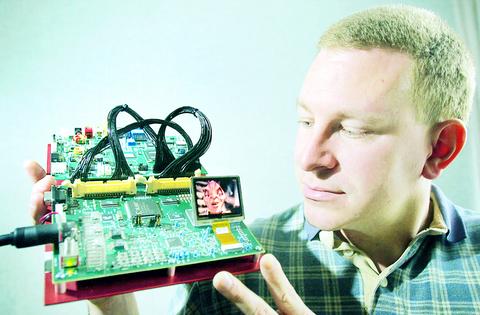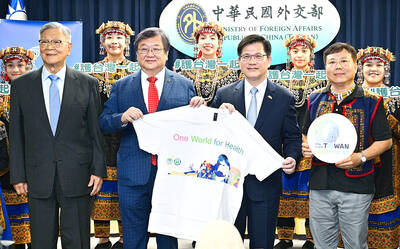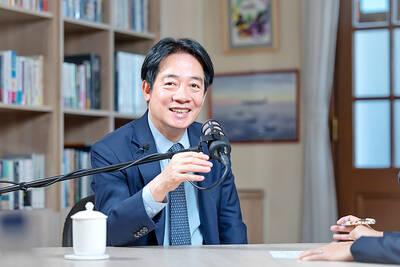A new technology that makes cellphone screens glow like a firefly's tail may well be destined to brighten displays on everything from televisions to digital cameras.
Built on organic molecules or polymers that glow when they're electrified, the technology could even spur the currently unattainable: roll-up computer screens that can fit in a breast pocket or sheets of radiant lighting that shimmer like the aurora borealis.
"Imagine a plastic film or a fiber-optic cable that emits light, that you can bend in any shape you want," said Stewart Hough, vice president at Cambridge Display Technologies, "It's one of those limited-by-your-imagination things."

PHOTO: AP
Hough's company is developing a polymer-based version of the technology, known as organic light-emitting diodes or OLEDs (A diode is a piece of electronics in which current flows in only one direction).
Chemical, electronics and lighting companies -- including Kodak, Samsung, Philips, DuPont and others -- are pouring funds into research and development of OLEDs, rushing tiny screens to market and scrambling to race ahead of competitors.
For now, the monochrome screens appear on a handful of products: cell phones, an MP3 player, car stereos. As the bright new screens mature into full-color displays with an active matrix that permits video, analysts say they'll jump to digital camera displays, auto dashboards, laptop screens and TVs.
Global sales of OLEDs, estimated at just US$80 million this year, are expected to jump to US$2.3 billion by 2008, said Kimberly Allen, research director at iSuppli/Stanford Resources, a firm that tracks the industry.
As OLEDs progress, analysts say they'll replace the silicon-based LCD, or liquid crystal display technology, that's used in everything from watches and calculators to flat-screen monitors and some TVs.
OLED screens are made up of of arrays of tiny diodes made of organic materials used in plastics and polymers. The diodes in today's little screens are sandwiched between layers of glass, glowing in various colors as electricity flows through them.
The delicate organics wither and die at a hint of moisture, so glass is needed to keep them dry.
Experts say it will be a decade or so before someone figures out how to make a durable OLED screen on a plastic base, perhaps a flexible one, which would require flexible circuit boards and other components.
A few companies, including DuPont and Lucent Technologies' Bell Labs, are already working on bendable plastic electronics for such a screen.
"You could put it on curved surfaces," said Alan Heeger, professor of physics at University of California at Santa Barbara. "You can imagine nifty-looking things."
Heeger, whose discoveries in polymer conductivity earned him and two colleagues a Nobel prize in 2000, said the innovations in lighting could be more dramatic than those in consumer electronics.
OLEDs, coupled with mature inorganic LED technology that already brightens traffic signals and auto taillights, could replace incandescent and fluorescent light bulbs with wallpaper that changes lighting patterns and colors, sheets of radiant film that could be cut to size or light cords that accent walls, handrails or steps, Heeger said.
Today's OLED-bearing products are comparatively mundane.
The first emerged in a Pioneer car stereo in 1998. Since then, they've shown up in cell phones made by Motorola, Fujitsu and LG, an MP3 player made by Taiwanese firm Delta Optoelectronics and a Philips men's shaver sold under the Norelco brand in the US.
The shaver, with its orange screen that displays battery life, turned up in the recent James Bond movie Die Another Day.
For next year, Samsung is making a cell phone with the first full-color OLED display, for sale in South Korea, Allen said.
And Kodak is quietly shipping 5cm horizontal OLED screens to a consumer device manufacturer it refused to name.
Those screens, configured in the manner of those used in digital cameras, are the first to use active-matrix technology that can play video, said Daniel Gisser of Kodak's display products unit. The product will emerge in the first half of next year, Gisser said.
Larger screens for handheld computers and video cameras might be ready in a year or two, said Paul O'Donovan, an analyst with Gartner Dataquest.
Prototypes of 38cm and 43cm screens have been cooked up, although none are expected to hit stores for years. O'Donovan said OLED PC monitors might be available in four to five years, televisions in five to 10.
"The trouble is scaling them up," O'Donovan said. "They've got a 6.3cm screen working impressively. The real technological leap will be to expand these into the replacement of TVs."

Nvidia Corp yesterday unveiled its new high-speed interconnect technology, NVLink Fusion, with Taiwanese application-specific IC (ASIC) designers Alchip Technologies Ltd (世芯) and MediaTek Inc (聯發科) among the first to adopt the technology to help build semi-custom artificial intelligence (AI) infrastructure for hyperscalers. Nvidia has opened its technology to outside users, as hyperscalers and cloud service providers are building their own cost-effective AI chips, or accelerators, used in AI servers by leveraging ASIC firms’ designing capabilities to reduce their dependence on Nvidia. Previously, NVLink technology was only available for Nvidia’s own AI platform. “NVLink Fusion opens Nvidia’s AI platform and rich ecosystem for

‘WORLD’S LOSS’: Taiwan’s exclusion robs the world of the benefits it could get from one of the foremost practitioners of disease prevention and public health, Minister Chiu said Taiwan should be allowed to join the World Health Assembly (WHA) as an irreplaceable contributor to global health and disease prevention efforts, Minister of Foreign Affairs Lin Chia-lung (林佳龍) said yesterday. He made the comment at a news conference in Taipei, hours before a Taiwanese delegation was to depart for Geneva, Switzerland, seeking to meet with foreign representatives for a bilateral meeting on the sidelines of the WHA, the WHO’s annual decisionmaking meeting, which would be held from Monday next week to May 27. As of yesterday, Taiwan had yet to receive an invitation. Taiwan has much to offer to the international community’s

CAUSE AND EFFECT: China’s policies prompted the US to increase its presence in the Indo-Pacific, and Beijing should consider if this outcome is in its best interests, Lai said China has been escalating its military and political pressure on Taiwan for many years, but should reflect on this strategy and think about what is really in its best interest, President William Lai (賴清德) said. Lai made the remark in a YouTube interview with Mindi World News that was broadcast on Saturday, ahead of the first anniversary of his presidential inauguration tomorrow. The US has clearly stated that China is its biggest challenge and threat, with US President Donald Trump and US Secretary of Defense Pete Hegseth repeatedly saying that the US should increase its forces in the Indo-Pacific region

ALL TOGETHER: Only by including Taiwan can the WHA fully exemplify its commitment to ‘One World for Health,’ the representative offices of eight nations in Taiwan said The representative offices in Taiwan of eight nations yesterday issued a joint statement reiterating their support for Taiwan’s meaningful engagement with the WHO and for Taipei’s participation as an observer at the World Health Assembly (WHA). The joint statement came as Taiwan has not received an invitation to this year’s WHA, which started yesterday and runs until Tuesday next week. This year’s meeting of the decisionmaking body of the WHO in Geneva, Switzerland, would be the ninth consecutive year Taiwan has been excluded. The eight offices, which reaffirmed their support for Taiwan, are the British Office Taipei, the Australian Office Taipei, the